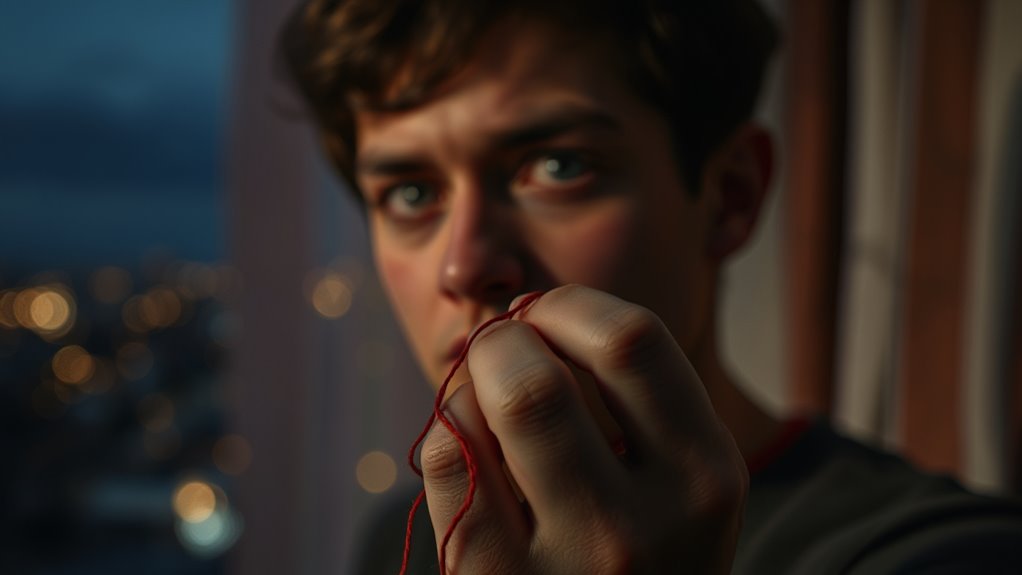If you have an anxious attachment style, you might find yourself obsessively craving reassurance and fearing abandonment, which can fuel love addiction. Your need for constant validation leads you to overanalyze every interaction, seeking signs of love while clinging tightly to your partner. These patterns often cause you to become overly dependent, pushing your partner away in the process. Understanding how your attachment style influences these behaviors can help you break free from the cycle—there’s more to explore.
Key Takeaways
- Anxious attachment causes intense craving for reassurance, leading to obsessive behaviors in love relationships.
- Fear of abandonment drives hypervigilance, increasing dependency and compulsive need for constant validation.
- Overanalyzing partner actions to prevent perceived rejection fuels emotional obsession and attachment insecurities.
- Deep-rooted fears and insecurities from anxious attachment reinforce love addiction patterns.
- Recognizing attachment style helps break the cycle of obsession and develop healthier relationship behaviors.

Understanding your attachment style can be key to recognizing patterns in your romantic relationships, especially if you find yourself struggling with love addiction. When you have an anxious attachment style, you often crave closeness and reassurance but worry about losing your partner or being abandoned. This intense fear fuels a cycle of seeking constant validation and reassurance, which can quickly turn into obsession. You might find yourself obsessively checking your phone, rereading messages, or constantly seeking signs of love or commitment from your partner. Your mind races with worries of rejection, and these fears become magnified by your need for reassurance, leading you to become overly dependent on your partner’s attention and approval.
Because your emotional needs feel urgent, you tend to interpret neutral or ambiguous actions as signs of rejection or disinterest. A simple delay in a reply or a change in tone can trigger feelings of panic, prompting you to seek reassurance again and again. This pattern often causes you to cling more tightly, fearing that any distance or independence from your partner signals an impending breakup. Your desire for closeness becomes intertwined with fear, making it difficult to maintain healthy boundaries or to understand that your partner’s actions don’t necessarily reflect rejection. Instead, they may be rooted in their own needs or circumstances. Recognizing that attachment styles are shaped by early experiences can help you understand why these patterns develop and persist. Developing cultural intelligence can also support you in understanding diverse relationship dynamics and cultural influences on attachment behaviors.
This cycle of anxiety and obsession can feel exhausting, both for you and for your partner. Your heightened sensitivity to perceived rejection might lead you to overanalyze every interaction, searching for hidden meanings or signs of trouble. Your mind can spiral into worst-case scenarios, convincing you that you’re destined to be alone or unloved. As a result, you may become overly possessive or controlling, trying to prevent abandonment by micromanaging your partner’s behavior or demanding constant reassurance. This behavior, unfortunately, often pushes your partner away, reinforcing your fears and deepening your love addiction. Recognizing that these patterns are often reinforced by emotional dependencies can help you approach your relationship with more awareness and compassion. Cultivating self-awareness and understanding your triggers can also be vital in breaking this cycle.
Recognizing that your attachment style contributes to these patterns is empowering. It highlights that your fears are rooted in deep-seated beliefs about yourself and relationships. Understanding this can motivate you to seek healthier ways to manage your anxiety—like building self-esteem, setting boundaries, or seeking therapy. Cultivating practices such as mindfulness and emotional regulation can help you develop a more balanced perspective and reduce reactive behaviors. The goal isn’t to eliminate your attachment style but to understand it so you can develop healthier relationship patterns. With awareness and effort, you can learn to soothe your anxieties without resorting to obsession, fostering more secure, balanced connections and breaking free from the cycle of love addiction.
Frequently Asked Questions
Can Anxious Attachment Be Fully Healed With Therapy?
You might wonder if anxious attachment can be fully healed with therapy. While therapy can markedly improve your attachment patterns, it’s important to understand that healing is a process. With consistent effort, you can develop healthier relationship habits and reduce anxiety. However, some patterns may take time to change completely. Be patient and open to ongoing self-awareness and growth, knowing that progress varies for everyone.
How Does Childhood Trauma Influence Attachment Styles?
Childhood trauma deeply impacts your attachment style by shaping how you trust others and seek intimacy. When you experience neglect, abuse, or inconsistency, you may develop anxious attachment, fearing abandonment and craving reassurance. These early wounds influence your emotional responses and relationship patterns, making it harder to feel secure. Recognizing this connection helps you understand your behaviors and work towards healing, ultimately fostering healthier relationships and emotional stability.
Are There Specific Signs of Love Addiction Beyond Attachment Issues?
Love addiction shows itself through signs like constantly craving reassurance, feeling anxious when you’re apart from your partner, and neglecting your needs for their attention. You might obsessively check their social media, feel incomplete without their validation, or struggle to set boundaries. These behaviors often stem from deep fears of abandonment or loneliness, making you overly dependent on love for self-worth. Recognizing these signs helps you take steps toward healthier relationships.
Can Someone Shift From Anxious to Secure Attachment?
Sure, you can shift from anxious to secure attachment—if you’re willing to do the work. Ironically, it’s easier than you think; just focus on building self-awareness, setting boundaries, and practicing self-compassion. By consistently challenging anxious thoughts and seeking healthy relationships, you’ll gradually develop confidence and stability. It’s a journey of self-discovery that rewards you with genuine connections and a more secure, peaceful love life.
What Role Does Self-Esteem Play in Love Obsession?
Self-esteem plays a vital role in love obsession because it influences how you perceive your worth and how much you seek validation through relationships. When your self-esteem is low, you might become overly fixated on your partner, fearing loss or rejection. This obsession stems from a desire to feel accepted and valued. Building your confidence helps you develop healthier boundaries and reduces the need for constant reassurance.
Conclusion
Understanding how anxious attachment fuels love addiction reveals that your deep fear of abandonment drives obsessive behaviors. While some believe love addiction is purely emotional, research suggests it’s rooted in attachment patterns shaped early in life. Recognizing this connection helps you see that overcoming obsession isn’t just about willpower but about healing attachment wounds. By addressing these underlying issues, you can foster healthier relationships and break free from cycles of dependency.









